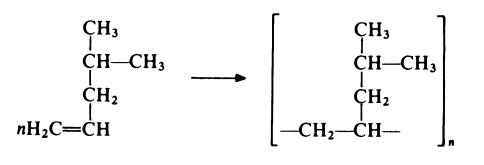
POLY(4-METHYL-1-PENTENE)
- русский язык имя
- английское имяPOLY(4-METHYL-1-PENTENE)
- CAS №25068-26-2
- CBNumberCB2229379
- ФормулаC6H12
- мольный вес84.15948
- номер MDLMFCD00084382
- файл Mol25068-26-2.mol
химическое свойство
| Температура плавления | 240 °C |
| Температура кипения | 0.83 °C |
| плотность | 0.835 g/mL at 25 °C |
| показатель преломления | n |
| форма | Beads |
| цвет | Clear |
| Справочник по базе данных CAS | 25068-26-2 |
| Непрямые добавки, используемые в веществах, контактирующих с пищевыми продуктами | POLY(4-METHYL-1-PENTENE) |
| Система регистрации веществ EPA | 1-Pentene, 4-methyl-, homopolymer (25068-26-2) |
| UNSPSC Code | 12162002 |
| NACRES | NA.23 |
| Заявления о безопасности | 24/25 |
| WGK Германия | 3 |
| кода HS | 39029090 |
POLY(4-METHYL-1-PENTENE) химические свойства, назначение, производство
Химические свойства
Poly(4-methyl-1-pentene) was first introduced in 1965 by Imperial Chemical Industries Ltd (UK) but since 1975 the polymer has been manufactured solely by Mitsui Petrochemical Industries Ltd. Polymerization is carried out using a Ziegler-Natta catalyst such as titanium trichloride/diethylaluminium chloride in a hydrocarbon diluent at atmospheric pressure and 30-60°C:
The commercial material contains a comonomer, possibly 1-hexene, which enhances clarity. The polymer configuration is predominantly isotactic. Generally, this material has the basic physical properties to be expected from a crystalline polyolefin but in some respects it offers significant improvements over other polyolefins. One outstanding property of poly(4-methyl-l-pentene) is the very low specific gravity, which at 0.83 is the lowest of current polymers. The crystalline melting point is 240°C and the Vicat softening temperature is 179°C; these high values mean that a useful form stability is maintained up to about 200°C. The transparency of the polymer is of a high order, being comparable to poly(methyl methacrylate) and polystyrene. Poly(4-methyl-l-pentene) exhibits resistance to oxidizing and other chemical environments broadly similar to that shown by polypropylene; however, poly(4-methyl-l-pentene) does undergo environmental stress cracking comparable to low density polyethylene. The permeability of poly(4-methyl-I-pentene) to gases and water vapour is considerably higher than that for other polyolefins. Poly(4-methyl-l-pentene) may be extruded and injection moulded using standard equipment. The material has been used in several applications where transparency and heat resistance are required, e.g. medical and laboratory ware.
Использование
Coating for paper food containers for microwave and conventional ovens. Release coatings for food and synthetic leather. Molded into medical labware. Film for decorative laminates and printed circuit boards.POLY(4-METHYL-1-PENTENE) поставщик
| поставщик | телефон | страна | номенклатура продукции | благоприятные условия |
|---|---|---|---|---|
| 18871490254 | CHINA | 28172 | 58 | |
| +86-023-6139-8061 +86-86-13650506873 |
China | 39894 | 58 | |
| +86-29-89586680 +86-15129568250 |
China | 22787 | 58 | |
| United States | 24072 | 58 | ||
| +1-+1(833)-552-7181 | United States | 52924 | 58 | |
| 021-61259108 18621169109 |
China | 40228 | 62 | |
| 010-89508211 18501085097 |
China | 9371 | 55 | |
| 800-810-5118 | China | 17770 | 75 | |
| 0512-87182056 18013166090 |
China | 7295 | 60 | |
| 15221275939 15221275939 |
China | 16166 | 55 |